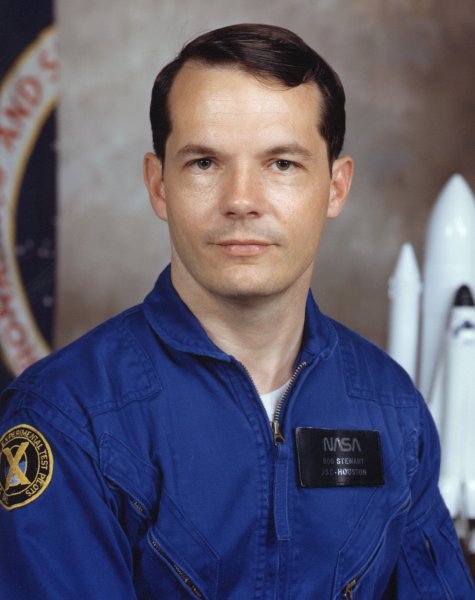- Robert L. Stewart
Infobox Astronaut
name =Robert Lee Stewart
type =NASA Astronaut
status =Retired
nationality =American
date_birth = birth date and age|1942|8|13
place_birth =Washington D.C.
occupation =Test Pilot
rank =Brigadier General, USA
selection =1978 NASA Group
time =12d 00h 49m
mission =STS-41-B ,STS-51-J
insignia =Robert Lee Stewart is a retired Brigadier General of the
United States Army and formerNASA astronaut .Personal
Stewart was born
August 13 ,1942 , inWashington D.C. . He graduated from Hattiesburg High School,Hattiesburg, Mississippi , in 1960. He went on to receive a bachelor of science degree inmathematics fromThe University of Southern Mississippi in 1964, and a master of science inaerospace engineering from theUniversity of Texas at Arlington , in 1972. He has been a member of theSociety of Experimental Test Pilots ,Association of Space Explorers ,Phi Eta Sigma , and theScabbard and Blade (a military honor society).Stewart is married and has two children. His interests include
woodworking ,photography , andskiing .Military career
Stewart entered on active duty with the United States Army in May 1964 and was assigned as an air defense artillery director at the 32nd NORAD Region Headquarters (SAGE),
Gunter Air Force Base ,Alabama . In July 1966, after completing rotary wing training atFort Wolters ,Texas , andFort Rucker ,Alabama , he was designated an Army aviator. He flew 1,035 hours combat time from August 1966 to 1967, primarily as a fire team leader in the armedhelicopter platoon of "A" Company, 101st Aviation Battalion (redesignated 336th Assault Helicopter Company). He was an instructor pilot at the U.S. Army Primary Helicopter School — serving 1 year in the pre-solo/primary-1 phase of instruction and about 6 months as commander of methods of instruction flight III, training rated aviators to become instructor pilots. He is a graduate of the U.S. Army's Air Defense School's Air Defense Officers Advanced Course and Guided Missile Systems Officers Course. Stewart served inSeoul, Korea , from 1972 to 1973, with the 309th Aviation Battalion (Combat) as a battalion operations officer and battalion executive officer. He next attended the U.S. Naval Test Pilot School atPatuxent River, Maryland , completing the Rotary Wing Test Pilot Course in 1974, and was then assigned as an experimentaltest pilot to the U.S. Army Aviation Engineering Flight Activity atEdwards Air Force Base ,California . His duties there included being chief of the integrated systems test division, as well as participating in engineering flight tests of UH-1 and AH-1 helicopters and U-21 and OV-1 fixed wing aircraft, serving as project officer and senior test pilot on the Hughes YAH-64 advanced attack helicopter during government competitive testing; and participation withSikorsky Aircraft Corporation test pilots in developing an electronic automatic flight control system for the new Army transport helicopter — the UH-60A Black Hawk.He has military and civilian experience in 38 types of airplanes and helicopters and logged approximately 6,000 hours total flight time.
NASA career
Stewart became a NASA astronaut in August 1979. His technical duties in the astronaut office included testing and evaluation of the entry flight control systems for
STS-1 (the first Space Shuttle orbital mission), ascent abort procedures development, and payload coordination. He also served as support crewman forSTS-4 , and Ascent/Orbit CAPCOM forSTS-5 . He served as a mission specialist onSTS-41-B in 1984 andSTS-51-J in 1985, and logged a total of 289 hours in space, including approximately 12 hours of EVA operations.In 1986, while in training for his scheduled third flight to be know as STS-61-K, Col Stewart was selected by the Army for promotion to Brigadier General. Upon accepting this promotion General Stewart was reassigned from NASA to be the Deputy Commanding General, US Army Strategic Defense Command, in
Huntsville, Alabama . In this capacity General Stewart managed research efforts in developing ballistic missile defense technology. In 1989, he was reassigned as the Director of Plans, US Space Command,Colorado Springs, Colorado .Later career
Stewart retired from the Army in 1992 and currently makes his home in
Woodland Park, Colorado . He is presently employed as Director, Advanced Programs,Nichols Research Corporation , Colorado Springs, Colorado.paceflight experience
STS-41-B Challenger (February 3-11, 1984) was launched fromKennedy Space Center ,Florida , and returned to land there 8-days later. During the mission, Stewart and McCandless participated in two extravehicular activities (EVA's) to conduct first flight evaluations of the Manned Maneuvering Units (MMU's). These EVA's represented man's first untethered operations from a spacecraft in flight. Upon completion of this mission Stewart became the first Army officer awarded the Army Astronaut Badge.STS-51-J Atlantis (October 3-7, 1985) was launched from Kennedy Space Center, Florida, and after 98 hours of orbital operations returned to land at Edwards Air Force Base, California. It was the second Space Shuttle Department of Defense mission, and the maiden voyage of Atlantis. During the mission he was responsible for a number of on-orbit activities.Awards and honors
*Distinguished Service Medal
*Defense Superior Service Medal
*Legion of Merit withoak leaf cluster
*Distinguished Flying Cross (4 Awards)
*Bronze Star
*Meritorious Service Medal
*Air Medal (33 Awards)
*Army Commendation Medal with oak leaf cluster andValor device
*Purple Heart with oak leaf cluster
*National Defense Service Medal
*Armed Forces Expeditionary Medal
*Vietnam Service Medal
*Vietnam Campaign Medal
*Vietnam Cross of Gallantry
*Army Aviation of the Year, 1984
*AHS Feinberg Memorial Award
*AIAA Oberth Award
*NASA Space Flight Medal s (1984 & 1985)External links
* [http://www.jsc.nasa.gov/Bios/htmlbios/stewart-rl.html NASA bio]
* [http://www.spacefacts.de/bios/astronauts/english/stewart_robert.htm Spacefacts biography of Robert Stewart]
Wikimedia Foundation. 2010.
